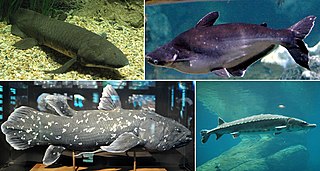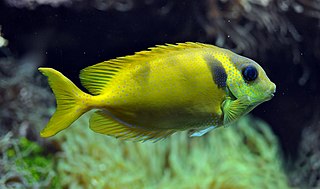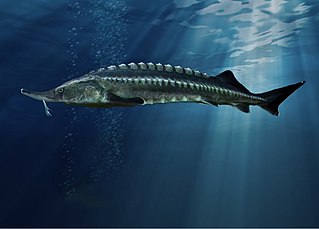
Actinopterygii, members of which are known as ray-finned fish or actinopterygians, is a class of bony fish that comprise over 50% of living vertebrate species. They are so called because of their lightly built fins made of webbings of skin supported by radially extended thin bony spines called lepidotrichia, as opposed to the bulkier, fleshy lobed fins of the sister class Sarcopterygii. Resembling folding fans, the actinopterygian fins can easily change shape and wetted area, providing superior thrust-to-weight ratios per movement compared to sarcopterygian and chondrichthyian fins. The fin rays attach directly to the proximal or basal skeletal elements, the radials, which represent the articulation between these fins and the internal skeleton.

Osteichthyes, commonly referred to as the bony fish, is a diverse superclass of vertebrate animals that have skeletons primarily composed of bone tissue. They can be contrasted with the Chondrichthyes, which have skeletons primarily composed of cartilage. The vast majority of extant fish are members of Osteichthyes, which is an extremely diverse and abundant group consisting of 45 orders, over 435 families and 28,000 species. It is the largest class of vertebrates in existence today.
Lampriformes is an order of ray-finned fish. Members are collectively called lamprids or lampriforms, and unite such open-ocean and partially deep-sea Teleostei as the crestfishes, oarfish, opahs, and ribbonfishes. A synonym for this order is Allotriognathi, while an often-seen, but apparently incorrect, spelling variant is Lampridiformes. They contain seven extant families which are generally small but highly distinct, and a mere 12 lampriform genera with some 20 species altogether are recognized.
Cadborosaurus, nicknamed Caddy by journalist Archie Wills, is a sea serpent in the folklore of regions of the Pacific Coast of North America. Its name is derived from Cadboro Bay in Greater Victoria, British Columbia, and the Greek root word "saurus" meaning lizard or reptile.

Neopterygii is a subclass of ray-finned fish (Actinopterygii). Neopterygii includes the Holostei and the Teleostei, of which the latter comprise the vast majority of extant fishes, and over half of all living vertebrate species. While living holosteans include only freshwater taxa, teleosts are diverse in both freshwater and marine environments. Many new species of teleosts are scientifically described each year.

The beluga, also known as the beluga sturgeon or great sturgeon, is a species of anadromous fish in the sturgeon family (Acipenseridae) of order Acipenseriformes. It is found primarily in the Caspian and Black Sea basins, and formerly in the Adriatic Sea. Based on maximum size, it is the third-most-massive living species of bony fish. Heavily fished for the female's valuable roe, known as beluga caviar, wild populations have been greatly reduced by overfishing and poaching, leading IUCN to classify the species as critically endangered.

Oarfish are large, greatly elongated, pelagic lampriform fish belonging to the small family Regalecidae. Found in areas spanning from temperate ocean zones to tropical ones, yet rarely seen, the oarfish family contains three species in two genera. One of these, the giant oarfish, is the longest bony fish alive, growing up to 11 m (36 ft) in length.

Skinningrove is a village in the civil parish of Loftus, in the Redcar and Cleveland district, in the ceremonial county of North Yorkshire, England. Its name is of Old Norse etymology and is thought to mean skinners' grove or pit.

The giant oarfish is a species of oarfish of the family Regalecidae. It is an oceanodromous species with a worldwide distribution, excluding polar regions. Other common names include Pacific oarfish, king of herrings, ribbonfish, and streamer fish.

Euteleostei, whose members are known as euteleosts, is a clade of bony fishes within Teleostei that evolved some 240 million years ago. It is divided into Protacanthopterygii and Neoteleostei.

Rhadinorhynchidae is a family of parasitic worms from the order Echinorhynchida.
Lophotus is a genus of crestfishes with these currently recognized species:

Agrostichthys parkeri, also called the streamer fish, is a species of oarfish. Only seven identified specimens have been examined, with few found fully intact, and have mainly been found in the Southern Ocean. Agrostichthys parkeri belongs to the Regalecidae (oarfish) family in the Lampriformes order and is the only known member of its genus. This species has been known to grow up to 3 metres (9.8 ft) long and has a ribbon-like body, two large eyes, a protruding mouth and long filamentous rays originating at the head. Due to only seven specimens being found, only the distribution and anatomy of Agrostichthys parkeri can be documented.
Tyson Royal Roberts is an American ichthyologist. He has been described as "the world's foremost authority on Regalecus".

The Neoteleostei is a large clade of bony fish mostly consisting of marine clades. Only three lineages have freshwater species: Percopsiformes (Troutperches), which lives exclusively in freshwater, Gadiformes (cods), which is largely marine except from burbot that live in freshwater and a few populations of cod in brackish water, and the Percomorpha, which in addition to several marine groups also have many freshwater forms.
The crested oarfish is a species of crestfish in the family Lophotidae. It is an oceanodromous fish ranging from waters 0–92 meters deep, but may get stranded in shallow waters.

Regalecus russelii, or Russell's oarfish, is a species of oarfish in the family Regalecidae. It is a broadly-distributed marine fish, found in waters in the bathypelagic zone. R. russelii is a scaleless, elongate and ribbonlike fish, growing up to 8 meters in length.

Adolf (Adolph) Ulric Grill was a Swedish ironworks owner and scientific collector of animals and fossils for his cabinet of curiosities at Söderfors Manor, Tierp Municipality, Uppsala County, Sweden.













